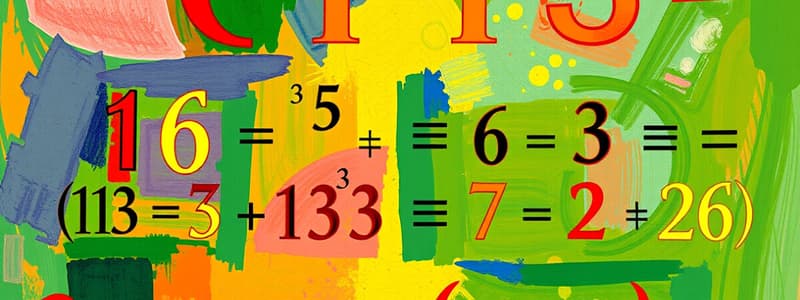Podcast
Questions and Answers
What is the common difference in the arithmetic sequence 2, 5, 8, ...?
What is the common difference in the arithmetic sequence 2, 5, 8, ...?
- 1
- 2
- 3 (correct)
- 4
Using the formula for the nth term, what is the 10th term of the sequence 3, 7, 11, ...?
Using the formula for the nth term, what is the 10th term of the sequence 3, 7, 11, ...?
- 37 (correct)
- 39
- 35
- 33
Does the number 12 belong to the arithmetic sequence 210, 197, 184, ...?
Does the number 12 belong to the arithmetic sequence 210, 197, 184, ...?
- Yes, it is the 13th term
- Yes, it is the 14th term
- No, it is not a term (correct)
- Yes, it is the 16th term
If the first term of an arithmetic sequence is 5 and the common difference is -2, what is the formula for the nth term?
If the first term of an arithmetic sequence is 5 and the common difference is -2, what is the formula for the nth term?
How do you find if a number belongs to a given arithmetic sequence?
How do you find if a number belongs to a given arithmetic sequence?
What is the correct formula for the sum of the first n terms of the arithmetic series given in the content?
What is the correct formula for the sum of the first n terms of the arithmetic series given in the content?
If the first term of the arithmetic series is 2 and the common difference is 3, what is the formula for the sum of the first n terms?
If the first term of the arithmetic series is 2 and the common difference is 3, what is the formula for the sum of the first n terms?
Using the method of pairing the terms in an arithmetic series with common difference d, which of the following represents the paired sums correctly?
Using the method of pairing the terms in an arithmetic series with common difference d, which of the following represents the paired sums correctly?
Which statement is true regarding the arithmetic series and its sum?
Which statement is true regarding the arithmetic series and its sum?
What is the value of $S_{100}$ for the series $1 + 2 + 3 + ··· + 100$?
What is the value of $S_{100}$ for the series $1 + 2 + 3 + ··· + 100$?
Flashcards are hidden until you start studying
Study Notes
Arithmetic Sequences
- An arithmetic sequence consists of terms generated by adding a constant, known as the common difference (d), to the previous term.
- General form: ( a, a + d, a + 2d, a + 3d, \ldots )
- Example: The sequence of even numbers ( 2, 4, 6, 8, 10, \ldots ) has ( d = 2 ).
- The formula for the nth term is given by: ( a_n = a + (n - 1)d ).
Examples of nth Term Calculations
-
For the sequence ( 2, 5, 8, \ldots ):
- ( a = 2, d = 3 )
- ( a_n = 2 + (n − 1) \times 3 = 3n − 1 ).
-
For the sequence ( 107, 98, 89, \ldots ):
- ( a = 107, d = -9 )
- ( a_n = 107 + (n - 1) \times -9 = 116 - 9n ).
Membership in an Arithmetic Sequence
- To determine if a number belongs to an arithmetic sequence, solve ( a_n = 203 ).
- For the sequence ( 3, 7, 11, \ldots ) (where ( a = 3, d = 4 )):
- Set ( 4n - 1 = 203 ) leading to ( n = 51 ), confirming 203 is the 51st term.
Geometric Sequences
- A geometric sequence features terms obtained by multiplying the previous term by a constant known as the common ratio (r).
- General form: ( a, ar, ar^2, ar^3, \ldots )
- Example: The doubling sequence ( 1, 2, 4, 8, 16, 32, 64, \ldots ).
Summation of Arithmetic Series
- The sum of an arithmetic series ( S_n = 1 + 2 + 3 + \ldots + n ) leads to the formula ( S_n = \frac{n(n + 1)}{2} ).
- This can be derived by adding the series forwards and backwards, simplifying each pair of terms.
Sum Formula for Specific Examples
-
For the series ( 2, 5, 8, \ldots ):
- ( S_n = \frac{n}{2} (2 + (3n - 1)) = \frac{n(3n + 1)}{2} ).
-
For the series ( 107, 98, 89, \ldots ):
- ( S_n = \frac{n}{2} (107 + (116 - 9n)) = \frac{n(223 - 9n)}{2} ).
Geometric Series Summation
- The sum of a geometric series is expressed as ( S_n = \frac{a(r^n - 1)}{r - 1} ) for ( r \neq 1 ).
- Example: For the series ( 2 + 8 + 32 + 128 + \ldots ):
- First term ( a = 2 ), common ratio ( r = 4 ).
- Resulting in: ( S_n = \frac{2(4^n - 1)}{4 - 1} = \frac{2(4^n - 1)}{3} ).
Additional Concepts
- Arithmetic and geometric means can be extended to more numbers, defined through averages.
- Important inequality: For positive numbers ( a ) and ( b ), the inequality ( \frac{1}{2}(a + b) \geq \sqrt{ab} ) holds.
- Limitations of geometric series converge under conditions, notably ( -1 < r < 1 ).
Historical Note
- Mathematical discoveries attributed to Gauss relate to the summation technique of arithmetic series, noted for its elegance.
Studying That Suits You
Use AI to generate personalized quizzes and flashcards to suit your learning preferences.




